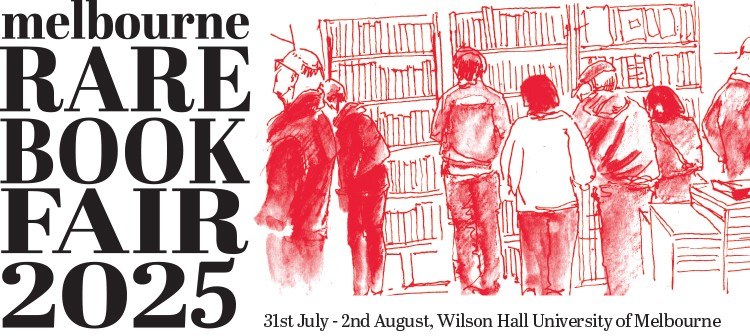Highlights

Each year our exhibitors bring extraordinarily rare, beautiful and unusual items for sale.
Leading up to the fair, you will find here, highlights, selected by our exhibitors, of the wide range of items that will be on exhibition and for sale at this year's fair.
Bookmark this page and visit again as our exhibitors will be adding highlights over the next two months
If something is of interest, please contact the exhibitor directly. They will welcome your enquiry.
Les Amours de Psyche et de Cupidon
$5500
One of the most striking editions of Fontaine’s adaptation of the story of Cupid and Psyche with coloured stipple engravings by Bonnefoy, Mme Demonchy, and Colibert after Jean-Frederic Schall. This copy extra illustrated and finely bound by the Paris bookbinder Salvador David.
View More
さいころ独楽. 日本酒附録. [1930s Sake Advertising Campaign].
$450
Sixteen delightful small porcelain spinning tops measuring 2.0 x 1.7cm in size each accompanied by ten handsome colour printed product labels heightened in gilt with soft purple cord ties (8.3 x 6cm).
These sake promotional giveaways and accompanying die-cut cards in the shape of the Order of the Golden Kite are advertisements associated with Meiyo-gura, a sake brand sold in Nihonbashi, Tokyo.
The advertisement describes a koma (spinning top), attached beneath the bottle top, which could also serve as a small entertainment item.
View More
John Stuart Mill: Utilitarianism
$9500
London, Parker, Son, and Bourn, 1863 [first edition in book form].
Mill's definitive statement on moral philosophy. The text was first published as a series of three articles in 'Fraser's Magazine' in 1861; this first edition in book form is rare.
Bib and Bub Painting Book. New Stories by May Gibbs
$1250
Oblong quarto (210 × 305 mm), [24] pages of black and white comic-strip artwork plus text on the covers.
A rare and charming 'colouring book', the last of May Gibbs' Bib and Bub titles.
Bury My Heart at Wounded Knee | Dee Brown
$3900
An American bestseller in hard cover for over a year post publication, selling many millions of copies and was translated into seventeen languages, Brown became a celebrated author of both fiction and non-fiction until he died in 2002.
View More
Ah! Nana
$1200
Complete set of the French women’s comic magazine. Ah!Nana ran for nine issues, each with its own theme, coming to a short end following the magazine being banned to minors after the publication of the eighth issue devoted to homosexuality. This led the editorial team to go all in on the ninth and final issue, devoting it to incest, leading to the French censorship Commission banning the publication, labelling it pornographic.
View More
The Satanic Verses | Signed Copy | Salman Rushdie
$8000
This immaculate first edition, signed and dedicated by the author, will further become one of the prize editions in English literature. Rushdie is understandably unlikely to ever commit to any public signings again.
View More
Madman's Island. By Ion L. Idriess.
$550
Sydney, Angus & Robertson, 1938. Octavo, frontispiece, 24 Percy Lindsay illustrations, map on endpapers, 4pp. publisher's advertisements, some foxing but very good in original orange cloth lettered and ruled in black with bright pictorial dustwrapper (bit chipped). First edition thus. First issue dustwrapper with fabulous (unsigned) Percy Lindsay art (subsequently issued with a variant silhouette pictorial dustwrapper).
Hobart Town
$2450
Rare c.19th detailed hand coloured engraved panorama of Hobart published in 1879. From the original edition of the Australasian Sketcher.
View More
Moby Dick
$39000
Melville, Herman.
Moby-Dick; or, The Whale.
1st edition. 1851. New York: Harper & Brothers. Cochran copy, ex-Fisk Memorial Library, Natchez, Mississippi.12mo. Original brown cloth gilt, publisher’s circular blindstamp upper board in bespoke clamshell case; pp. xxiv (last blank), 636 (last blank), [6 publisher’s catalogue)]. [Tanselle 2]
Despite initial unfavourable criticism, there is good reason why Moby Dick often makes lists of the top ten books ever written. It contains the best exposition of Melville’s philosophical musings, every sentence loaded with import.
The Birds of Australia
$750000
London : printed by Richard and John Taylor for the author, 1848.
The first comprehensive survey of the birds of Australia, with hand-coloured illustrations and descriptions of 681 species, 328 of which were new to Western science and which Gould was the first to describe.
The finest of all Australian colour plate books, and Gould’s ‘greatest achievement’ (Wantrup).
Provenance:
Sir Edward Charles Stirling (1848-1919), Director of the South Australian Museum 1895 - 1913
View More
DOUGLAS, William Bloomfield. Diary kept while captain of a mail ship, commander of a government coastal survey, and government resident of the Northern Territory.
$104500
The valuable journal of the overly ambitious and power-hungry Captain Bloomfield Douglas, encompassing three important aspects of Australian colonial history: the evolution of the colony’s communications with the wider world, the quest to survey its coasts accurately, and the placing of control over colonized fringes in the hands of ill-suited soldiers of fortune.